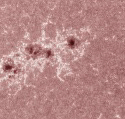|
|
Post by Kevin VE3EN on Feb 15, 2011 3:53:26 GMT
X2.2 Halo CME captured in Behind images  |
|
solarstormlover54
Level 2 Rank
  Hot and dry trend Since January. Looks to continue at least through the first half of May.
Hot and dry trend Since January. Looks to continue at least through the first half of May.
Posts: 54
|
Post by solarstormlover54 on Feb 15, 2011 4:17:38 GMT
Becoming cloudy in the evening. Snow beginning after midnight. Low minus 24.
What a waste of an X2 solar flare. If you have clear skies count your blessings.
|
|
|
|
Post by lsvalgaard on Feb 15, 2011 5:04:10 GMT
Becoming cloudy in the evening. Snow beginning after midnight. Low minus 24. What a waste of an X2 solar flare. If you have clear skies count your blessings. The aurorae caused by the flare are not due for another 1-2 days |
|
solarstormlover54
Level 2 Rank
  Hot and dry trend Since January. Looks to continue at least through the first half of May.
Hot and dry trend Since January. Looks to continue at least through the first half of May.
Posts: 54
|
Post by solarstormlover54 on Feb 15, 2011 5:10:34 GMT
That's the forecast over the next 3 days. Fairly large winter storm coming in from BC. IT is not expected to clear up around here until Friday
|
|
|
|
Post by jcarels on Feb 15, 2011 7:37:20 GMT
PRESTO FROM SIDC - RWC BELGIUM Tue Feb 15 2011, 0651 UT
NOAA AR 1158 has produced an X2.2 flare peaking at 01:56 UT, associated with an Earth directed CME. Furthermore, an M2.2 flare (from the same AR) peaking at 17:26 UT on February 14 had also an associated Earth directed CME. They are expected to arrive to the Earth around February 17.
Looks promising ;D
|
|
bradk
Level 3 Rank
  
Posts: 199
|
Post by bradk on Feb 15, 2011 7:51:03 GMT
No question we are seeing a light glow on the northern horizon here in the north central U.S. I have pretty good location far from city lights. This must be the first M. Finger crossed that the X hits during the night here.
|
|
|
|
Post by af4ex on Feb 15, 2011 10:19:56 GMT
Looking for the enrtry "XRA X2.2". Don't see it: www.swpc.noaa.gov/ftpdir/indices/events/events.txtI don't understand why NOAA hasn't posted this event yet. Also, looking at Nobeyama microwaves, I can see two more big AR1158 explosions at 0305Z and 0430Z, which NOAA hasn't reported yet. That 0430Z event was pretty big. maybe a low M- or high C-class flare. 1160 brightened up at 0520Z and produced a small B or C flare. They seem to be preoccupied with all the radio burst events lately. :-| Attachments:
|
|
|
|
Post by af4ex on Feb 15, 2011 13:01:06 GMT
Video replay of the X2.2-Flare in UV 1700A light. There was also one small flare before and two after the main event. (The last one might have been an 'M' flare (or close to it), but NOAA still hasn't reported _any_ of these flares, not even the X2.2)  Note that, unlike the M6.6 flare, there was no build-up of the dark magnetic areas prior to the big flare. Suggesting that 1158 was in a 'steady state', more or less. |
|
|
|
Post by davidwild on Feb 15, 2011 14:05:16 GMT
|
|
|
|
Post by af4ex on Feb 15, 2011 14:30:33 GMT
Thanks for that update. I hope the bureaucrats will get around to fixing the reports some day. :-| Welcome to Solar Cycle 24! |
|
|
|
Post by af4ex on Feb 15, 2011 15:11:10 GMT
Ok, NOAA finally updated the event log for the X2.2 flare (but not for the pre- and post-shocks. And they forgot to mention it was region #1158. Arrgh)
#Event Begin Max End Obs Q Type Loc/Frq Particulars Reg#
#-------------------------------------------------------------------------------
6880 0144 0156 0206 G15 5 XRA 1-8A X2.2 1.6E-01
|
|
|
|
Post by davidwild on Feb 15, 2011 15:45:55 GMT
Thanks! I've been reading for a while and decided it was time to join. Any guesses on how bad the CME impact is going to be on either the Kp or NOAA scale? (http://www.swpc.noaa.gov/NOAAscales/)
|
|
|
|
Post by af4ex on Feb 15, 2011 16:29:16 GMT
> Any guesses on how bad the CME impact is going to be ...
Don't know, this is my first X-Flare (as a solar-watching enthusiast). Perhaps some of the elders in the SC24 clan may be able to answer that question.
|
|
|
|
Post by davidwild on Feb 15, 2011 16:41:53 GMT
It would be interesting to see a table of historical M and X class flares (ordered by magnitude) that produced earthbound CME's, along with the maximum Kp they produced. Any ideas anyone?
|
|
|
|
Post by af4ex on Feb 15, 2011 16:58:58 GMT
I asked a similar question when I first came on board here. Never got an answer. So, AFAIK, nobody "officially" detects, numbers and records these events as they happen (on the sun) or keeps a record if and when they hit the Earth (and 'magnitude' of the encounter).
To do this would require several 'formalisms' to be defined and agreed upon:
1. Definition of CME
a. ID number and classification
b. spatial-temporal extent
c. magnitude/energy etc
d. direction of ejection
e. impact Earth (or other planet)?
f. magnitude of planetary impact
g. archiving and reporting formats
So another non-trivial issue of general scientific interest for the NOAA/NASA bureaucrats to ponder and decide upon. Someday soon I'm sure. /sarc off [They can't even record X-flares properly when they happen]
:-|
|
|